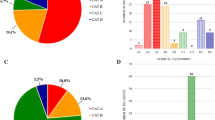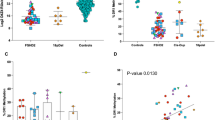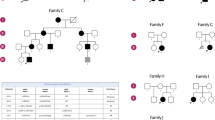Abstract
Facioscapulohumeral muscular dystrophy (FSHD) is an autosomal dominant neuromuscular disorder which maps to chromosome 4qter, distal to the D4S139 locus. The cosmid clone 13E, isolated in a search for homeobox genes, was subsequently mapped to 4q35, also distal to D4S139. A subclone, p13E–11, detects in normal individuals a polymorphic EcoRI fragment usually larger than 28 kilobases (kb). Surprisingly, using the same probe we detected de novo DNA rearrangements, characterized by shorter EcoRI fragments (14–28 kb), in 5 out of 6 new FSHD cases. In 10 Dutch families analysed, a specific shorter fragment between 14–28 kb co–segregates with FSHD. Both observations indicate that FSHD is caused by independent de novo DNA rearrangements in the EcoRI fragment detected by p13E–11.
This is a preview of subscription content, access via your institution
Access options
Subscribe to this journal
Receive 12 print issues and online access
$209.00 per year
only $17.42 per issue
Buy this article
- Purchase on SpringerLink
- Instant access to full article PDF
Prices may be subject to local taxes which are calculated during checkout
Similar content being viewed by others
References
Munsat, T.L. Facioscapulohumeral dystrophy and the scapuloperoneal syndrome. In Myology (eds Engel, A.G. & Banker, B.Q.) 1251–1266 (McGraw Hill, New York, 1986).
Padberg, G.W. Facioscapulohumeral disease (thesis, Leiden University, 1982).
Lunt, P.W., Compston, D.A.S. & Harper, P.S. Estimation of age dependent penetrance in Facioscapulohumeral muscular dystrophy by minimising ascertainment bias. J. med. Genet. 26, 755–760 (1989).
Lunt, P.W. & Harper, P.S. Genetic counseling in facioscapulohumeral muscular dystrophy. J. med. Genet. 28, 655–664 (1991).
Collins, F.S. Positional cloning: Let's not call it reverse anymore Nature Genet. 1, 3–6 (1992).
Wijmenga, C. et al. Location of facioscapulohumeral muscular dystrophy gene on chromosome 4. Lancet 336, 651–653 (1990).
Upadhyaya, M. et al. DNA marker applicable to presymptomatic and prenatal diagnosis of facioscapulohumeral disease. Lancet 336, 1320–1321 (1990).
Wijmenga, C. et al. Mapping of facioscapulohumeral muscular dystrophy gene to chromosome 4q35-qter by multipoint linkage analysis and in situ hybridisation. Genomics 9, 570–575 (1991).
Sarfarazi, M. et al. Regional mapping of facioscapulohumeral disease on 4q35. Combined analysis of an international consortium. Am. J. hum. Genet. (in the press).
Mills, K.A. et al. Genetic and physical mapping in the 4q35 region near the gene for FSHD. Am. J. hum. Genet. (in the press).
Callen, D.F., Baker, E.G. & Lane, S.A. Re-evaluation of GM2346 from a del(16)(q22) to t(4;16)(q35;q22.1). Clinic. Genet. 38, 466–468 (1990).
Miller, S.A., Dykes, D.D. & Polesky, H.F. A simple salting out procedure for extracting DNA from nucleated cells. Nucl. Acid. Res. 16, 1215 (1988).
Church, G.M. & Gilbert, W. Genome Sequencing. Proc. natn. Acad. Sci. U.S.A. 81, 1991–1995 (1984).
Hewitt, J.E., Clark, L.N., Ivens, A. & Williamson, R. Sructure and sequence of the human homeobox gene HOX7. Genomics 11, 670–678 (1991).
Langer, P.R., Waldrop, A.A. & Ward, D.C. Enzymatic synthesis of biotin labelled polynucleotides: novel nucleic acid affinity probes. Proc. natn. Acad. Sci. U.S.A. 78, 6633–6637 (1981).
Weber, J.L. & May, P.E. Abundant class of human DNA polymorphisms which can be typed using the polymerase chain reaction. Am. J. hum. Genet. 44, 388–396 (1989).
Author information
Authors and Affiliations
Rights and permissions
About this article
Cite this article
Wijmenga, C., Hewitt, J., Sandkuijl, L. et al. Chromosome 4q DNA rearrangements associated with facioscapulohumeral muscular dystrophy. Nat Genet 2, 26–30 (1992). https://doi.org/10.1038/ng0992-26
Received:
Accepted:
Issue Date:
DOI: https://doi.org/10.1038/ng0992-26



